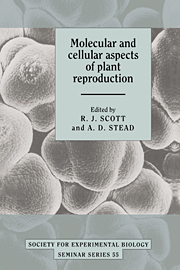Book contents
- Frontmatter
- Contents
- List of Contributors
- Introduction: ‘Where do we go from here?’
- Molecular control of floral organogenesis and plant reproduction in Petunia hybrida
- Control of floral morphogenesis in cauliflower (Brassica oleracea L. var. botrytis): the role of homeotic genes
- Isolation and properties of mutants of Arabidopsis thaliana with reduced sensitivity to short days
- Asexual mutants in Melandrium album (Silene alba): tools in cDNA cloning and analysis of an X/Y chromosome system in plants
- Pollen exine – the sporopollenin enigma and the physics of pattern
- The diversity and regulation of gene expression in the pathway of male gametophyte development
- Characterisation of Arabidopsis thaliana anther-specific gene which shares sequence similarity with β-1,3-glucanases
- Ovule cDNA clones of Petunia hybrida encoding proteins homologous to MAP and shaggy/zeste-white 3 protein kinases
- Towards the elucidation of the mechanisms of pollen tube inhibition during the self-incompatibility response in Papaver rhoeas
- Intracellular movement and pollen physiology: progress and prospects
- Organisation and functions of cell surface molecules on gametes of the brown algae Fucus
- Strategies of flower senescence – a review
- The physiology of petal senescence which is not initiated by ethylene
- Molecular biology of flower senescence in carnation
- Ethylene sensitivity and flower senescence
- Ethylene biosynthetic genes and inter-organ signalling during flower senescence
- Index
Molecular biology of flower senescence in carnation
Published online by Cambridge University Press: 04 August 2010
- Frontmatter
- Contents
- List of Contributors
- Introduction: ‘Where do we go from here?’
- Molecular control of floral organogenesis and plant reproduction in Petunia hybrida
- Control of floral morphogenesis in cauliflower (Brassica oleracea L. var. botrytis): the role of homeotic genes
- Isolation and properties of mutants of Arabidopsis thaliana with reduced sensitivity to short days
- Asexual mutants in Melandrium album (Silene alba): tools in cDNA cloning and analysis of an X/Y chromosome system in plants
- Pollen exine – the sporopollenin enigma and the physics of pattern
- The diversity and regulation of gene expression in the pathway of male gametophyte development
- Characterisation of Arabidopsis thaliana anther-specific gene which shares sequence similarity with β-1,3-glucanases
- Ovule cDNA clones of Petunia hybrida encoding proteins homologous to MAP and shaggy/zeste-white 3 protein kinases
- Towards the elucidation of the mechanisms of pollen tube inhibition during the self-incompatibility response in Papaver rhoeas
- Intracellular movement and pollen physiology: progress and prospects
- Organisation and functions of cell surface molecules on gametes of the brown algae Fucus
- Strategies of flower senescence – a review
- The physiology of petal senescence which is not initiated by ethylene
- Molecular biology of flower senescence in carnation
- Ethylene sensitivity and flower senescence
- Ethylene biosynthetic genes and inter-organ signalling during flower senescence
- Index
Summary
Introduction
The programmed senescence of flower petals is a highly controlled developmental event and plays an important role in the overall reproductive strategy of many plants (see Stead & van Doom, this volume). The flower is a terminally differentiated complex structure composed of many organs performing a variety of functions, the ultimate goal being successful sexual reproduction. These functions include the production of pollen, pollination, fusion of gametes, and the development and dispersal of viable seeds. In many species, the petals function in the attraction of insects for pollination. Consistent with the petals' short-lived role in reproduction, pollination often serves as a signal for the initiation of petal senescence (Stead, 1992). In the flowers of carnation, the phytohormone ethylene serves as a signal for the initiation of petal senescence following pollination (Nichols, 1977; Nichols et al., 1983). In the absence of pollination petal senescence in carnation still occurs and is mediated by the increased production of ethylene (Nichols, 1966; Wang & Woodson, 1989). This paper attempts to summarise recent data on the regulation of programmed organ death in carnation flower petals with a particular focus on the molecular events associated with the induction of senescence by ethylene. It is not intended as an exhaustive review of flower senescence, for which the reader is referred to papers by Borochov and Woodson (1989), Cook and van Staden (1988), and Reid and Wu (1992).
- Type
- Chapter
- Information
- Molecular and Cellular Aspects of Plant Reproduction , pp. 255 - 268Publisher: Cambridge University PressPrint publication year: 1994
- 6
- Cited by



